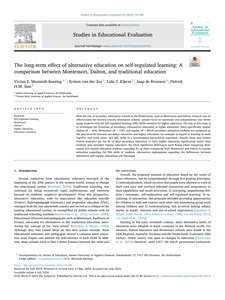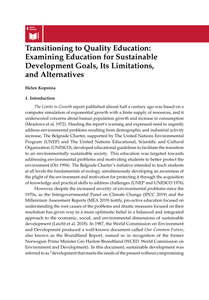Morssink-Santing, V. E., van der Zee, S., Klaver, L. T., de Brouwer, J., andamp; Sins, P. H. (2024). The long-term effect of alternative education on self-regulated learning: A comparison between Montessori, Dalton, and traditional education. Studies in Educational Evaluation, 83, 101380. https://doi.org/10.1016/j.stueduc.2024.101380
MULTIFILE

In the past years teacher education colleges have started to offer more alternative routes to teaching in secondary education. The development is a response to teacher shortages but also to a change in thinking about teaching as a profession, professional learning and the school as site of learning. Three alternative routes were studied. The characteristics of the new students and the way teacher colleges adapt their programmes to these new students are discussed. The alternative teacher education programmes realize characteristics of work-based learning to a certain extent, but not fully yet. Alternative routes are a promising development in teacher education, opening new opportunities to enter teaching, and marking a change in the role of schools as important environment of teachers professional learning.
DOCUMENT
Building on the Millennium Development Goals, Education for Sustainable Development (ESD) and Education for Sustainable Development Goals (ESDG) were established. Despite the willingness of many educational institutions worldwide to embrace the SDGs, given escalating sustainability challenges, this article questions whether ESDG is desirable as “an education for the future”. Many challenges outlined by the SDGs are supposed to be solved by “inclusive” or “sustainable” economic growth, assuming that economic growth can be conveniently decoupled from resource consumption. Yet, the current hegemony of the sustainability-through-growth paradigm has actually increased inequalities and pressure on natural resources, exacerbating biodiversity loss, climate change and resulting social tensions. With unreflective support for growth, far from challenging the status quo, the SDGs and consequently, the ESDGs, condone continuing environmental exploitation, depriving millions of species of their right to flourish, and impoverishing future generations. This article creates greater awareness of the paradoxes of sustainable development and encourages teaching for sustainability through various examples of alternative education that emphasizes planetary ethic and degrowth. The alternatives include Indigenous learning, ecopedagogy, ecocentric education, education for steady-state and circular economy, empowerment and liberation. “This is an Accepted Manuscript of an article published by Taylor & Francis in 'Journal of Environmental Education' on 01/20/20, available online: https://www.tandfonline.com/doi/full/10.1080/00958964.2019.1710444 LinkedIn: https://www.linkedin.com/in/helenkopnina/
MULTIFILE

Teacher education is in a state of change. There is a new focus on professional competence, including the competence for further development and learning, conceived of as workplace learning. Teacher shortages put pressure on the development of alternative routes to teaching. The arrival of prospective teachers with experience and qualifications in other areas than education requires adaptive programs, with a greater emphasis on professional learning in school. It is argued that promoting professional workplace learning asks for a conceptual clarification, based on new theory of learning and concepts of professionalism. A definition of professional learning is proposed. Some examples of new practice in teacher education are discussed.
DOCUMENT

“In-Between” is the title of this conference. If I am right, it focuses on the role of the artist as a middle-man, or middle-woman, between art and learner. It focuses, maybe, on the way artists are capable to transfer knowledge, skills, attitudes, insights, emotions of an artistic nature. And it focuses, maybe, on the way experiences from the domain of the arts may be transferred through the mechanism inherent in the domain of education; two domains which sometimes seem to have a rather problematic relation because the arts are seen as a domain of beauty, of expressivity, of individuality, of freedom, of creativity, whereas education is seen as the domain of standardization, of group work, of compliance to rules, and of mastering the existing.
DOCUMENT

More than 25!years after Moore’s first introduction of the public value concept in 995, the concept is now widely used, but its operationalization is still considered difficult. This paper presents the empirical results of a study analyzing the application of the public value concept in Higher Education Institutions, thereby focusing on how to account for public value. The paper shows how Dutch universities of applied sciences operationalize the concept ‘public value’, and how they report on the outcome achievements. The official strategy plans and annual reports for FY2016 through FY2018 of the ten largest institutions were used. While we find that all the institutions selected aim to deliver public value, they still use performance indicators that have a more narrow orientation, and are primarily focused on processes, outputs, and service delivery quality. However, we also observe that they use narratives to show the public value they created. In this way this paper contributes to the literature on public value accounting.
DOCUMENT

Innovation is crucial for higher education to ensure high-quality curricula that address the changing needs of students, labor markets, and society as a whole. Substantial amounts of resources and enthusiasm are devoted to innovations, but often they do not yield the desired changes. This may be due to unworkable goals, too much complexity, and a lack of resources to institutionalize the innovation. In many cases, innovations end up being less sustainable than expected or hoped for. In the long term, the disappointing revenues of innovations hamper the ability of higher education to remain future proof. Against the background of this need to increase the success of educational innovations, our colleague Klaartje van Genugten has explored the literature on innovations to reveal mechanisms that contribute to the sustainability of innovations. Her findings are synthesized in this report. They are particularly meaningful for directors of education programs, curriculum committees, educational consultants, and policy makers, who are generally in charge of defining the scope and set up of innovations. Her report offers a comprehensive view and provides food for thought on how we can strive for future-proof and sustainable innovations. I therefore recommend reading this report.
DOCUMENT

Chapter in a book. Discusses the concept of idiocultural music education.
DOCUMENT
Despite the willingness of many educational institutions worldwide to embrace Education for Sustainable Development and Education for Sustainable Development Goals, critical scholars have pointed out that the very enterprise of sustainable development is not without its contradictions. Therefore, any education that engages with sustainable development needs to be carefully reviewed, rather than supported, in its ambition to promote the supposedly universally desirable aims. The rhetoric of sustainable development as meeting the needs of present and future generations is largely anthropocentric in failing to take nonhuman species into account when setting up pragmatic and ethical objectives. Similarly to the Millennium Development Goals (MDGs) that have helped to raise living standards across the world, but have largely failed to address environmental sustainability challenges, the Sustainability Development Goals (SDGs) tend to prioritize “inclusive economic growth” at the expense of ecological integrity, which is very likely to negatively affect not only nonhuman species but also future generations and their quality of life. Thus, as this chapter will argue, universally applicable Education for Sustainable Development Goals (ESDGs) is problematic in the context of addressing the long-term sustainability for both human and nonhuman inhabitants of the planet. Given escalating climate change, biodiversity loss, pollution, and depletion of natural resources, this chapter questions whether ESDGs can qualify as a desirable “quality education”. The paradoxes of sustainable development and ways forward that seem a better alternative for ESDG include indigenous/traditional learning, ecopedagogy, ecocentric education, and education for degrowth, steady-state, and Cradle-to-Cradle and circular economy. Advantages of universal education are also highlighted, as any education that supports basic literacy, numeracy, and values attributed to the intrinsic rights of humans and nonhumans can help students to be equipped to deal with social and environmental challenges. https://doi.org/10.3390/books978-3-03897-893-0-1 LinkedIn: https://www.linkedin.com/in/helenkopnina/
MULTIFILE

Over the past decade, the maker movement and in its slipstream maker education have attained worldwide popularity among educators, politicians, and the media. Makers’ enthusiasm for creative design and construction, using old and new tools has proven contagious, and is worth exploration and critical reflection by the community of engineering and technology education (ETE). This chapter describes what has been said about “making” by philosophers and educators; what maker education is, and what is new and not so new about it; why it has gained momentum; what the evidence is about its effectiveness and its possible weaknesses; and how mainstream technology education may benefit from maker education. This chapter concludes with ideas for a research agenda.
LINK